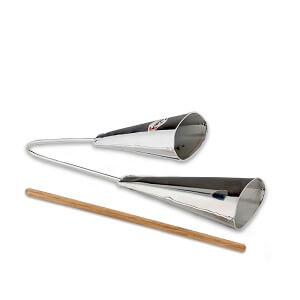Agogo
 The agogô is a bell idiophone associated with Afro-Brazilian culture of Brazil. It is used alongside the berimbau and other instruments to accompany capoeira and also for African-derived religious practices such as candomblé. The agogô has also become a standard instrument in samba baterias. Many Brazilian and Afro-Brazilian popular music artists include the agogô in their rhythmic sections, especially when Afro-Brazilian rhythms or grooves are incorporated into songs.
The agogô is a bell idiophone associated with Afro-Brazilian culture of Brazil. It is used alongside the berimbau and other instruments to accompany capoeira and also for African-derived religious practices such as candomblé. The agogô has also become a standard instrument in samba baterias. Many Brazilian and Afro-Brazilian popular music artists include the agogô in their rhythmic sections, especially when Afro-Brazilian rhythms or grooves are incorporated into songs.
The agogô consists of two cone-shaped iron bells with their apexes connected by a common handle made from a hook-shaped iron rod. The bells differ in size, but are both made from fan-shaped pieces of sheet iron rolled into cones with the resulting seams welded together. The tips of these cones are then welded to the ends of the handle so that the larger bell extends further forward than the smaller one. The rod beater can be made either from wood or iron.
‘Agogô’ is originally an African word, used by the Yoruba, Igala, and Edo peoples of Nigeria to signify a single or double clapperless bell. African slaves brought the word agogô and the instrumental concept to the Americas, where it was resurrected and utilized both in form and function over time as circumstances permitted and practices evolved.